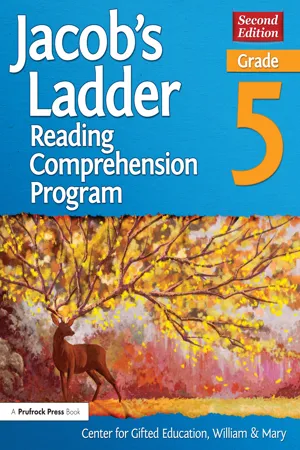
Jacob's Ladder Reading Comprehension Program
Grade 5
- 190 pages
- English
- ePUB (mobile friendly)
- Available on iOS & Android
About This Book
The Jacob's Ladder Reading Comprehension Program targets reading comprehension skills in high-ability learners by moving students through an inquiry process from basic understanding to critical analyses of texts, using a field-tested method developed by the Center for Gifted Education at William & Mary. Students in grade 5 will learn to comprehend and analyze any reading passage after completing the activities in Jacob's Ladder, Grade 5 (2nd ed., previously published as Level 3).
Research conducted by the Center for Gifted Education with Title 1 students demonstrated that the Jacob's Ladder Reading Comprehension Program delivers results related to improved reading comprehension, increased critical thinking, and an enhanced interest in reading. Using skill ladders connected to short stories, poetry, essays, and nonfiction, students move from lower order, concrete thinking skills to higher order, critical thinking skills. The ladders include multiple skills necessary for academic success, covering language arts standards such as sequencing, determining cause and effect, classifying, inferencing, and recognizing main ideas. The second edition of the book builds off the previous Level 3 edition, including new readings and ladders for student use.
This book provides teachers with an explanation of the nature of supplementary tasks that scaffold reading comprehension. Also included is an overview of the goals and objectives of the Jacob's Ladder tasks and suggestions for implementation, giving every teacher the tools needed to promote successful reading comprehension.
Optional Student Workbook Packs
In addition to this teacher's guide, companion student workbooks are available for Poetry, Short Stories, and Nonfiction and Essays/Speeches. The student workbooks feature ample room for student responses and notes, make reviewing and providing feedback on student work easier than ever, provide students with an easy-to-use reference to use during discussions, and save time, as there is no need to reproduce student handouts.
Grade 5
Frequently asked questions
Information
Part I: Teachers’ Guide to Jacob’s Ladder Reading Comprehension Program
Introduction to Jacob’s Ladder, Grade 5
| A3: Consequences and Implications | B3: Generalizations | C3: Main Idea, Theme, or Concept | D3: Creative Synthesis | |||
| Students will be able to predict character actions, story outcomes, and make real-world forecasts. | Students will be able to make general statements about a reading and/or an idea within the reading, using data to support their statements. | Students will be able to identify a major idea, theme, or concept common throughout the text. | Students will create something new using what they have learned from the reading and their synopses. | |||
| A2: Cause and Effect | B2: Classifications | C2: Inference | DD: Summarizing | |||
| Students will be able to identify and predict relationships between character behavior and story events, and their effects upon other characters or events. | Students will be able to categorize different aspects of the text or identify and sort categories from a list of topics or details. | Students will be able to use textual clues to read between the lines and make judgments about specific textual events, ideas, or character analysis. | Students will be able to provide a synopsis of text sections. | |||
| AA: Sequencing | BB: Details | C1: Literary Elements | DD: Paraphrasing | |||
| Students will be able to list, in order of importance or occurrence in the text, specific events or plot summaries. | Students will be able to list specific details or recall facts related to the text or generate a list of ideas about a specific topic or character. | Students will be able to identify and explain specific story elements, such as character, setting, or poetic device. | Students will be able to restate lines read using their own words. | |||
| Ladder A | Ladder B | Ladder C | Ladder D |
Ladder A: Focus on Implications and Consequences
- Ladder A, Rung 1, Sequencing: The lowest rung on the ladder, sequencing, requires students to organize a set of information in order, based on their reading (e.g., List the steps of a recipe in order).
- Ladder A, Rung 2, Cause and Effect: The middle rung, cause and effect, requires students to think about relationships and identify what causes certain effects and/or what effects were brought about because of certain causes (e.g., What causes a cake to rise in the oven? What effect does the addition of egg yolks have on a batter?).
- Ladder A, Rung 3, Consequences and Implications: The highest rung on Ladder A requires students to think about both short-term and long-term events that may happen as a result of an effect they have identified (e.g., What are the short-term and long-term consequences of baking at home?). Students learn to draw consequences and implications from the text for application in the real world (e.g., What are the short-term and long-term consequences of not saving any money?). Students learn to see implications and determine consequences from text for application in the real world. An implication is a possible result of an action. A consequence is the actual result of an ac...
Table of contents
- Cover
- Half Title
- Title Page
- Copyright Page
- Table of Contents
- Part I: Teachers’ Guide to Jacob’s Ladder Reading Comprehension Program
- Part II: Readings and Student Ladder Sets
- Appendix A: Pre- and Postassessments and Exemplars
- Appendix B: Record-Keeping Forms/Documents
- Answer Key
- Common Core State Standards Alignment